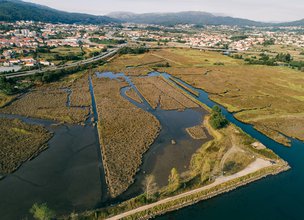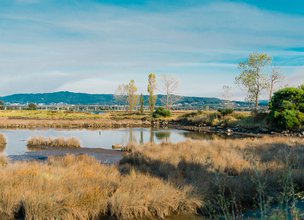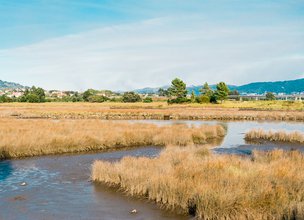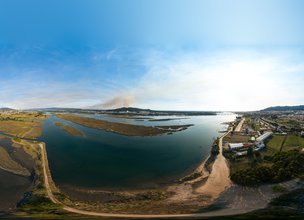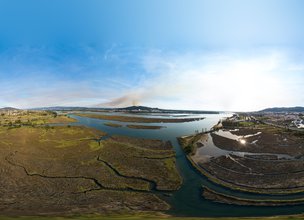The toponym Argaçosa, with its origins in argaço (Almeida Fernandes, 1994, pp. 31 to 33), reveals the importance of picking up seaweed in this place. Both the collection of seaweed and the extraction of salt were possible due to the free entry of seawater in this area of the Lima estuary, before the progressive silting of its bed, especially from the 15th century.
Salt pans are a complex articulated system of ditches, channels and tanks for decanting and evaporating water. This system is separated by dikes and embankments, which are colonized by typical marshland vegetation. The most common species are: salicornia (Salicornia ramosissima), perennial glasswort (Sarcocornia perennis) and sea purslane (Halimione portulacoides). Nowadays, it will be difficult to observe and interpret on the ground, this set of components of the Argaçosa salt pans, which are no longer in operation.
The salt pans are a very important biotope for shorebirds, offering them food, even during the high tide, as well as refuge and shelter from the wind.
Between Meadela and Santa Marta de Portuzelo we can find one of the largest medieval salt pans in Minho, as demonstrated by Brochado de Almeida (2005).
The toponym Argaçosa, with its origins in argaço (Almeida Fernandes, 1994, pp. 31 to 33), reveals the importance of picking up seaweed in this place. Both the collection of seaweed and the extraction of salt were possible due to the free entry of seawater in this area of the Lima estuary, before the progressive silting of its bed, especially from the 15th century.
Salt pans are a complex articulated system of ditches, channels and tanks for decanting and evaporating water. This system is separated by dikes and embankments, which are colonized by typical marshland vegetation. The most common species are: salicornia (Salicornia ramosissima), perennial glasswort (Sarcocornia perennis) and sea purslane (Halimione portulacoides). Nowadays, it will be difficult to observe and interpret on the ground, this set of components of the Argaçosa salt pans, which are no longer in operation.
The salt pans are a very important biotope for shorebirds, offering them food, even during the high tide, as well as refuge and shelter from the wind.
Between Meadela and Santa Marta de Portuzelo we can find one of the largest medieval salt pans in Minho, as demonstrated by Brochado de Almeida (2005).
Location
União de Freguesias de Monserrate, Santa Maria Maior e Meadela
Coordinates
Lat: 41.6984694
Long: -8.8043056
Hello little one!
I'm Piquinhos and I can help you learn more about the Geopark!
Technical details
Child Mode
Discover the geopark in a simpler format, aimed at the little ones.
Clique ENTER para pesquisar ou ESC para sair
